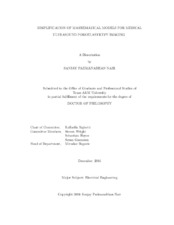| dc.contributor.advisor | Righetti, Raffaella | |
| dc.creator | Nair, Sanjay Padmanabhan | |
| dc.date.accessioned | 2017-03-02T16:45:11Z | |
| dc.date.available | 2018-12-01T07:21:23Z | |
| dc.date.created | 2016-12 | |
| dc.date.issued | 2016-09-27 | |
| dc.date.submitted | December 2016 | |
| dc.identifier.uri | https://hdl.handle.net/1969.1/158964 | |
| dc.description.abstract | The use of an understanding of mechanical properties of tissues for the purposes of medical diagnosis has been going on since the foundation of the medical field as a science. In recent decades, medical ultrasound elastography techniques have been developed and improved and have helped the medical community improve the state of diagnosis and tracking of various diseases like cancer, and lymphedema. Poroelastography, refers to the extension of ultrasound elastography techniques towards imaging the mechanical properties of tissues that are modeled as poroelastic.
Currently, the field of poroelastography is stuck, largely due to the complication in the mathematical models surrounding poroelastic materials. This dissertation focuses on the investigation of the suitability of a simplified equation involving a single saturating exponential (i.e. time constant curve) to describe the local time-dependent strain response of non-homogeneous poroelastic materials placed under creep compression. A new algorithm of measuring how precisely a non-linear equation fits a set of data samples from an experiment, the Resimulation of Noise (RoN) algorithm, was developed and implemented for the time constant curve case. The RoN algorithm was shown to track the precision of the fit in a more intuitive and accurate manner than previously used quality of fit metrics.
The RoN algorithm coupled with an in-depth FEM simulation study was conducted to see how well the single exponential time-constant curve fit the localized strain samples of a simulated prismatic phantom with a cylindrical inclusion under different permeability and stiffness contrasts. The study showed that, on average, the single exponential time constant curve was suitable within 10% precision for 90% of the phantom's area so long as a mean-mask filter was applied the localized strain images before attempting the curve-fit.
Future work in the field of poroelasticity imaging should center around the use of the single exponential time constant curve. This will require the development of a full understanding of how poroelastic material parameter contrast affects the contrast of the measured time constants. Procedures that will help this endeavor: such as the parallelization of the RoN algorithm as well as the development of novel nonhomogeneous poroelastic phantoms with the aid of 3-D printers are also proposed. | en |
| dc.format.mimetype | application/pdf | |
| dc.language.iso | en | |
| dc.subject | poroelasticity imaging | en |
| dc.subject | elastography | en |
| dc.subject | least square error | en |
| dc.subject | ultrasound | en |
| dc.subject | medical imaging | en |
| dc.subject | image processing | en |
| dc.subject | signal processing | en |
| dc.subject | FEM | en |
| dc.title | Simplification of Mathematical Models for Medical Ultrasound Poroelasticity Imaging | en |
| dc.type | Thesis | en |
| thesis.degree.department | Electrical and Computer Engineering | en |
| thesis.degree.discipline | Electrical Engineering | en |
| thesis.degree.grantor | Texas A & M University | en |
| thesis.degree.name | Doctor of Philosophy | en |
| thesis.degree.level | Doctoral | en |
| dc.contributor.committeeMember | Wright, Steven | |
| dc.contributor.committeeMember | Hoyos, Sebastian | |
| dc.contributor.committeeMember | Goenezen, Sevan | |
| dc.type.material | text | en |
| dc.date.updated | 2017-03-02T16:45:11Z | |
| local.embargo.terms | 2018-12-01 | |
| local.etdauthor.orcid | 0000-0001-6817-6027 | |


